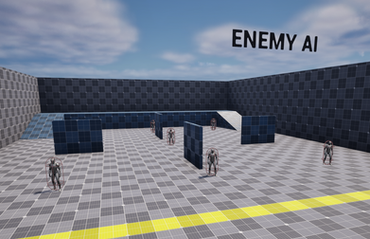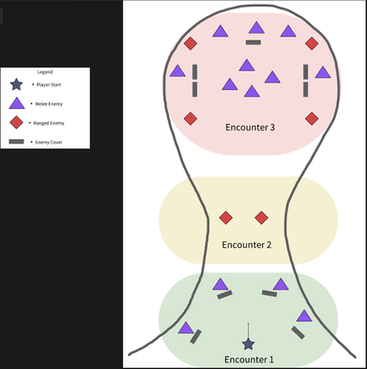Ironetic
Ironetic is a third-person Combat Prototype where the character uses a dynamic armor made of magnetic IronSand to strategically strike at enemies while also tactically tanking damage.
Project Type
Combat Prototype - 5 Person Team
Date
January 2025 - April 2025
Roles
Level Design | Combat Design
Link
Itch.io Page



My Role
My involvement in this project has required me to take on various roles. Luckily, I was able to use the knowledge I learned from many different classes to meet the demands of our weekly deliverables. After pitching the original concept, I became the primary vision holder and made it my responsibility to maintain constant documentation of our processes and tasks.
I started our agile development by providing the preliminary prototype. I then worked as a Level Designer to set up our developer gymnasium, with metrics and organized testing areas. I helped the engineers set up basic blueprint systems, such as character armor state transitions, custom button inputs for debugging, respawning, and basic AI enemy movement. I used my knowledge from my Realtime VFX class to work with Unreal's Niagara system and add a variety of new VFX to our animation montages. I also made sure to add sound cues in the blueprints and animations to enable consistent signifiers for the player.
Toward the end of the project, our team's other Level Designer and I worked together to create a level blockout for the combat encounters. We carefully crafted the scenario to meet our design goals of time-to-completion and difficulty progression. I used the Landscape tool to sculpt the environment to blend with the block out, then kitbashed together a scene with assets and lighting. Lastly, I placed the navmeshes in the scene as well as some subtle collision box triggers for ambient sound effects. Overall, I have been passionate about this project, and I hope my dedication shows through all the details and time I have dedicated to polish and game feel.
My Process
The idea for Ironetic began in the Fall of 2022 when I pitched my first draft to over 200 other students in my Capstone class. Iterating further upon the idea, I pitched it again to my Graduate class in the Fall of 2024. Both times, it was not successfully received. I made a design document detailing my research, including my inspirations, a razor statement, and concept art of the character and environment. I even did some market analysis, and my research showed that there were no other games like it. To demonstrate the concept, I made a prototype in Unreal as well. Even though the concept was unique, the explanation of the science that inspired the idea was difficult to explain.
At the beginning of my last semester in the graduate program, I took a Combat Design class. We were required to create groups of 5 and make an action game prototype. We had deliverables and design journals due each week to document our progress and process. The first week started with me pitching Ironetic to my new team (for the third time). However, this time, I modified my proposed platformer mechanics and reworked them into an alternative usage for combat. My team accepted the idea, and at that point, the idea was no longer mine. However, I was happy to receive extremely beneficial input from my fellow developers as we slowly adapted the new core gameplay to reach a satisfying game feel.
Ideation
Due to the accelerated timeline of this project, my team and I had to design the prototype while simultaneously making it. While this allowed for rapid iteration, it was also a challenge I had the opportunity to address. The initial ideation took the form of a simple flowchart defining the character's three action states. I made this flowchart on a board using our productivity software, Lark. After determining the general idea and basic mechanics, I created a developer gymnasium level. As a level designer, I understand the crucial importance of metrics and how they must be established early on in conjunction with the game's mechanics to provide a flow state to players.
A few weeks before this class started, Amazon released its Secret Level series. I showed my team a clip of Episode 5 - Warhammer 40,000, and we drew inspiration from the tanky feeling of the Space Marine's armor and nonchalant but violent demeanor. We also drew inspiration from Sony's Spiderman games with the fast and agile movement combined with ranged attacks, in contrast to the heavy hits of Venom. Considering those inspirations, I began to make VFX in Niagara to generate black Iron sand for hit impacts, projectiles, and state transitions.
Visual Polish
From the beginning, my team and I wanted our combat to include smashing through groups of smaller enemies. However, after external playtests, we came to the realization that we needed better justification for each part of the character's armor systems as a resource. That is when I met with my team to discuss cutting and simplifying certain elements of our core gameplay. The decision was ultimately a good one, and by only having two states, we made the expectations of combat more straightforward, with only melee enemies and ranged flying enemies.
Game Assets
I searched for a variety of references and free assets that we could use in our project. In past game projects, using premade assets was usually prohibited to encourage students to create from scratch. So, this is one of the first opportunities I had where we could use (free, non-copyrighted, personal use licensed) outside resources to achieve the type of game feel we wanted. This freedom allowed us to focus more on the tiny details of polish, even down to the frame-by-frame analysis of animations, vfx, and sound effects. My team and I drew inspiration from a 2012 talk by Martin Jonasson & Petri Purho called Juice It or Lose It.
One of the things that I am most proud of is how I took our enemy drone model into Maya to rig and animate it. Then, in Unreal, I created dynamic materials within the blueprint to sequentially light up parts of the model when the drone sees the player character, charges up its shot, and fires a laser projectile. This was a good way to signify to the player when the drone was actively attacking the player while also providing them with the allowance of reaction time during the charge-up sequence.
Level Design
After our game's enemies and combat states had been tested and implemented in our gym, the other level designer on the team and I began to concept a level for our combat encounter. We already had a good idea in mind for the theme, so I drafted a 5-minute Top-Down map showing the basic progression between 3 encounters and the total number of enemies. The initial shape idea of the map was to evoke the feeling of enemies being dug into defensive positions, with the character arriving to clear them out. By providing simple cover in the first area, the environmental storytelling can hint at that emotion for players. The second shape was a narrower encounter and would act as an introduction to the ranged and flying drone enemies. The idea here was that players could not sneak around or get past the drone enemies without combat happening. It could also provide a better silhouette with leading lines to draw the player's attention to the danger ahead and the landmark behind that.
The last encounter would open to a wide circular area to give the player the opportunity to test the skills they had learned in the previous two areas. However, this encounter was more unique since the players would need to combine their heuristic knowledge to learn how to fight both enemy types at the same time. This is where the process of playtesting began over and over again. I enjoy playtesting my levels because I also find things to improve or fix. For example, I quickly realized that some of our tested variables did not feel how we wanted them to in the actual combat scenario in comparison with how they felt in the gym. I ended up modifying numbers such as enemy drone health and damage, as well as the distance and peripheral angle of their pawn sensing. I also reduced the players' resource costs for the shield they can use in the Half Armor State.
Once these mechanics felt more balanced, I modified the approach to and the layout of the third final encounter. Playtests revealed that going up the stairs to the third area would result in the player quickly becoming overwhelmed by the number of enemies. Since the total number of enemies still felt good in terms of difficulty and progression, I realized it was something as simple as providing a bit of cover for the player so that the enemy's pawn sensing would all be activated at the same time. This allowed for a more controlled approach to the fight and even better pacing as the player moved around in the arena from cover to cover, as they switched between states.
Post Mortem
The completion of the project allowed me to look back and appreciate all of the things that I learned about how to make a video game feel better to the player. From the complexity of controller inputs and 100 millisecond response times to the frame-by-frame breakdown of VFX and animations during Anticipation, Strike, Impact, and Recovery. I am grateful to my teacher, Troy Johnson, one of the lead Combat Designers on WB Avalanche's Hogwarts Legacy.
There are a few things that I wish we could have done differently. I have always appreciated when every part of a game feels intentionally designed. However, that is rarely ever the case. Most games are held together with duct tape behind the scenes, but the magic is never letting players see that. Behind every one of the systems we designed for Ironetic, we had intentional design reasons. For example, there was previously no cooldown on the Heavy Smash attack that the Heavy Armor could do. This allowed players to spam it over and over again. So, we needed there to be a cooldown between State changes and wanted the player to be switching states every ~30 seconds. We created an artificial requirement for the player to need to 'charge up' the heavy attack by performing light attacks (preferably on enemies). However, the fact that the state change was tied directly to an attack made the transition feel laborious and repetitive, limiting player volition. So, even though both parts were intentionally designed and both had valid reasons, they conflicted with how we wanted players to feel. I have learned that even when a game looks impressive, players won't enjoy playing if the core mechanics cause dissonance between their desired actions and the arbitrary restrictions of gameplay. I would want my future designs to "align what the player wants to do with the thing that they have to do," as Steve Lee said in his 2017 GDC talk.
Credits to the artists, creators, and tools below:
These assets were used under the Free Personal License on Fab.com via Epic Games, for educational purposes.











